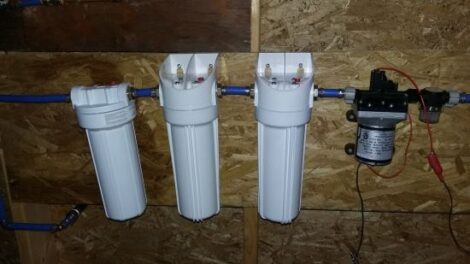It was a brisk, misty morning in the mountains of New Hampshire. The wind whipped what was left of the Grateful Dead flag as the fog slowly burned off over the mountains. It was another day of plumbing, a system that I thought would be easy, like ham-sandwich easy.
As it turns out, clamping a few pipes together is not as easy as it sounds. I carefully chose the locations for the pipes to be ran and began to drill holes through my newly framed cabin. I quickly connected the red pipes to the red pipes and the blue pipes to the blue pipes. I thought to myself that my fellow plumbers Mario and Luigi would be proud.
Maybe plumbing is ham-sandwich easy, I thought, as I went to install our new on demand water heater. Turns out, this was one tough ham sandwich to make.
Setting Up an Off-Grid Plumbing System
After installing a board to attach the water heater to, I began to cut out a hole for the vent. The vent went together easily and I couldn’t wait to get propane to test her out. With all the main lines connected, I began to install a series of three filters, connecting each section as I went.
I wanted to make sure that our water was clean — after all, we would likely be getting water from the local river this season. I grabbed our new 12-volt pump, connected it to our 50-gallon water tank, and ran out to grab the battery from our solar kit. A pair of test clips later, and the pump was humming a sweet song. I cautiously opened a valve and, magic! Water came at me with the force of woman scorn.
After the initial burst, I did a quick test and found it to be pumping a solid 3 gallons per minute. After all of my hard work,I finally decided now was the time to look at the manual.
Turns out the water heater needs a 18-inch rise of double-walled pipe, and a quick google search revealed our local building code required 18 inches of metal piping going in, and out of the heater. So after all my hard work, I drained the system, cut the pipes, and took down the water heater. I have always followed the measure once, cut twice method in all my building.
After the pipe kerfuffle, I re-ran the pipes, got new double-wall vent pipe, and installed the water heater again. Fortunately, this time I did it right.
5 Lessons Learned from DIY Plumbing Job
So what did I learn from this that I can share with my faithful readers? Here’s a few tips to avoid cutting multiple holes through your new wall.
1. PEX, PEX, PEX. Pex is a great product. For all of my previous plumbing projects, I soldered copper. Pex is less then half the cost of copper, it’s flexible, and easy to fix mistakes. It also comes in cool blue and red colors, and we all know how important style is off-grid.
2. Check your local building codes. Always be sure to check your local building codes, and speak with the inspector first. If I had taken my own advice, I wouldn’t have had to make the extra 4 runs to the local big box store.
3.Think about your run lengths. On a off grid homestead, water is life. Minimizing runs (especially with hot water) can help you save some of that hard earned water. Check to see how much water is in every foot of pipe for the product you are using.
4. Measure twice, cut once. Although I have mostly gone by measure once, cut twice, and then fix it after, forethought is a good thing that will save you time and money.
5. Get your water tested. Being from Massachusetts, I love that dirty water. The problem is dirty water in your house is bad, like giardia bad. Make sure you properly treat and filter your water and be sure to have it tested by someone that knows more than me.
Plumbing is a essential part to have a “normal” house off the grid. One of the main points of this project is to go off-grid without losing many luxuries. So that when friends come over, they would never know the difference between your house and theirs. Spend a little time researching before pulling that trigger.The use of jugs on the counter can easily be avoided with a couple dollars, a little research, and in my case, a lot of luck.
While most folks think that off-the-grid living is a life full of river dunks, outhouses, and chasing chickens, the reality is that an off-grid house can be almost as normal as a grid-tied one.
Jamie Leahy is founding mountaineer at North Ridge Mountain Guides. After a few years commuting to the White Mountains, Jamie and his girlfriend, Becky, decided it was time to move to New Hampshire’s White Mountains and follow their dream of building an off-grid, mini-homestead debt free. Follow him at White Mountains Off-Grid.Read all of his MOTHER EARTH NEWS posts here.
All MOTHER EARTH NEWS community bloggers have agreed to follow our Blogging Guidelines, and they are responsible for the accuracy of their posts. To learn more about the author of this post, click on their byline link at the top of the page.








